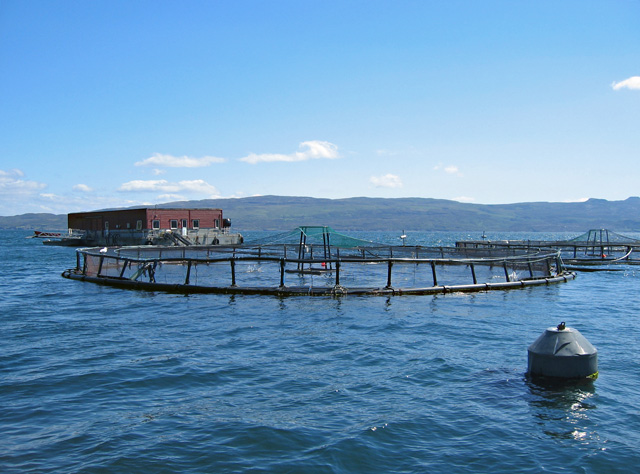Visit the seafood section at any supermarket and you’ll see numerous salmon filets laid out on ice, recognizable by the bright, orange color of their flesh. Tasty and easy to cook at home, salmon has always been in high demand and seemingly in high supply too — although the seafood section hardly reveals the entire story. Take Atlantic salmon, for example. Known as the “king of fish,” the Atlantic salmon (Salmo salar) is an endangered species whose once glorious population now faces many threats. So how is it that we can easily buy Atlantic salmon at our local supermarkets? That’s because the filets we consume aren’t from wild Atlantic salmon, which no longer exist on a commercial level. Instead, they’re from farm-raised, domesticated salmon.
“The filets we consume aren’t from wild Atlantic salmon, which no longer exist on a commercial level. Instead, they’re from farm-raised, domesticated salmon.”
The domestication of salmon is a result of aquaculture, the controlled farming of fish and other aquatic organisms. It’s one of the fastest-growing food production sectors, with Atlantic salmon representing the most economically significant aquaculture product. Even so, Atlantic salmon’s history of domestication began only about a half-century ago, in 1971, when Norwegian scientist Trygyve Gjedrem and his team created the first breeding program for salmon. They used directional selection to cultivate salmon with desirable production-related traits, mainly faster growth. Within seven generations (14 years), they doubled their salmon’s growth rate.
“Aquaculture is supposed to allow wild fish populations to thrive by decreasing demand for wild-caught fish, yet our domesticated fish are invading their territories and gradually eliminating what we define as wild.”
Since then, aquaculturists have been relentless in their pursuit of the most efficient domesticated salmon. One Massachusetts-based company, AquaBounty, has developed a genetically engineered salmon called AquAdvantage Salmon, which can be farmed year-round (instead of during only two seasons) and grows at a faster rate than other farmed salmon. This is because it has a growth hormone gene from Pacific Chinook salmon, which is activated by a genetic promoter sequence from the cold-tolerant ocean pout.
So while domesticated salmon are still the same species as their wild counterparts, they display significant phenotypic differences. Some scientists even refer to this strain as Salmo domesticus. In comparison to S. salar, S. domesticus have faster growth, delayed maturation, altered gene-transcription profiles, higher stress tolerance, and reduced predator awareness. Smaller eyes, too, as one international team of researchers found when examining Atlantic salmon from Norway and Ireland.
These traits make domesticated salmon unfit for survival in their natural environments. At first glance, this does not seem like a huge issue; domesticated salmon remain confined in their farms, while wild salmon remain elsewhere, right? Turns out they’re not that separate after all. Globally, millions of salmon escape from fish farms every year, making their way to natural environments where they interact ecologically and genetically with wild salmon, an issue that many studies have attempted to examine and quantify. Even though domesticated salmon do not thrive in the wild, their abundant presence is enough to cause introgression, in which the domesticated strain genetically mixes with the wild strain through breeding, passing on the former’s maladaptive traits. Instead of generations of pure wild salmon, scientists are seeing hybrids with lower survival rates that are threatening the genetic integrity, productivity, and evolutionary trajectories of the original populations. Aquaculture is supposed to allow wild fish populations to thrive by decreasing demand for wild-caught fish, yet our domesticated fish are invading their territories and gradually eliminating what we define as wild.
The introgression of escaped domesticated salmon in wild populations is only one of aquaculture’s many concerns. Once full of promises to lessen pressure on wild fish populations and aid humans in our fight against global hunger, aquaculture has revealed itself to be increasingly problematic and is in dire need of reformation in order to be sustainable and make good on its promises. Ultimately, like many controversial environmental issues, it begs a re-examination of our relationship with nature as consumers and producers. Have we gone too far in our attempts to control nature’s resources and animals? How much do we value the concept of a truly wild organism?
There is certainly something to be said about our treatment of the “king of fish” in particular. These days, the scarce memory of wild Atlantic salmon has been replaced by pounds of farmed Atlantic salmon at the supermarkets. This means little to your average consumer, since farmed salmon tastes the same as wild salmon, but what lies behind every orange slab of flesh is the complex and ongoing history of humans’ domestication of once-wild animals.
Image courtesy of Wikimedia Commons
